Job Analysis Report: Analyzing Job Roles, HRM, and Strategic Expansion
VerifiedAdded on 2023/01/19
|6
|1004
|70
Report
AI Summary
This report provides a detailed analysis of job analysis, exploring various methods for data collection, including interviews and questionnaires, along with their pros and cons. It delves into the concept of competency models and how they are applied within organizations, emphasizing the importance of collaboration, communication, and employee appreciation. The report also examines the role of job analysis as the foundation of human resource management (HRM), highlighting its significance in recruitment, selection, training, and employee well-being. Furthermore, it discusses strategies for expanding services to include long-term care, encompassing both internal profiles and external oversight, providing insights into financial performance, decision-making, and the establishment of parameters for quality service delivery.
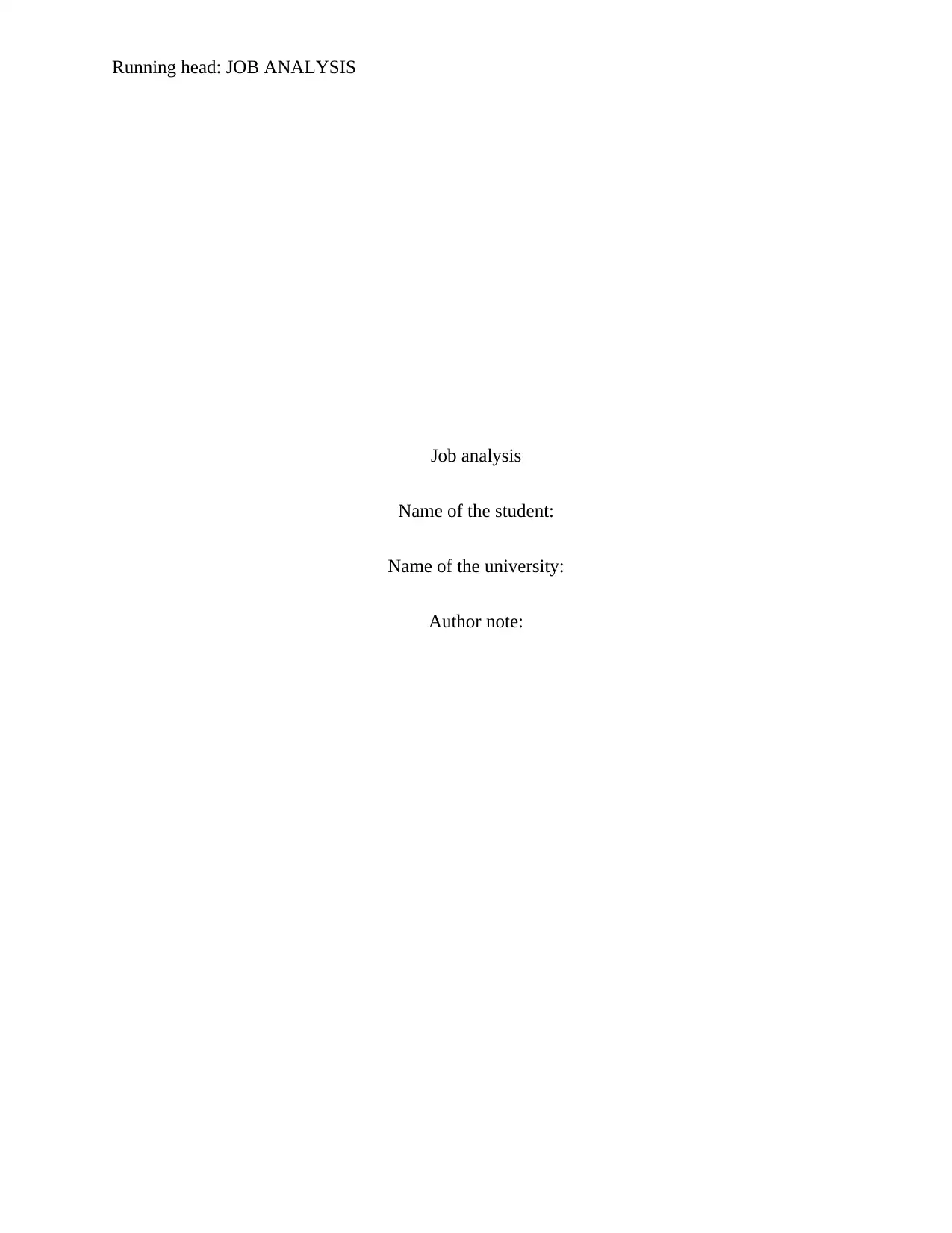
Running head: JOB ANALYSIS
Job analysis
Name of the student:
Name of the university:
Author note:
Job analysis
Name of the student:
Name of the university:
Author note:
Paraphrase This Document
Need a fresh take? Get an instant paraphrase of this document with our AI Paraphraser
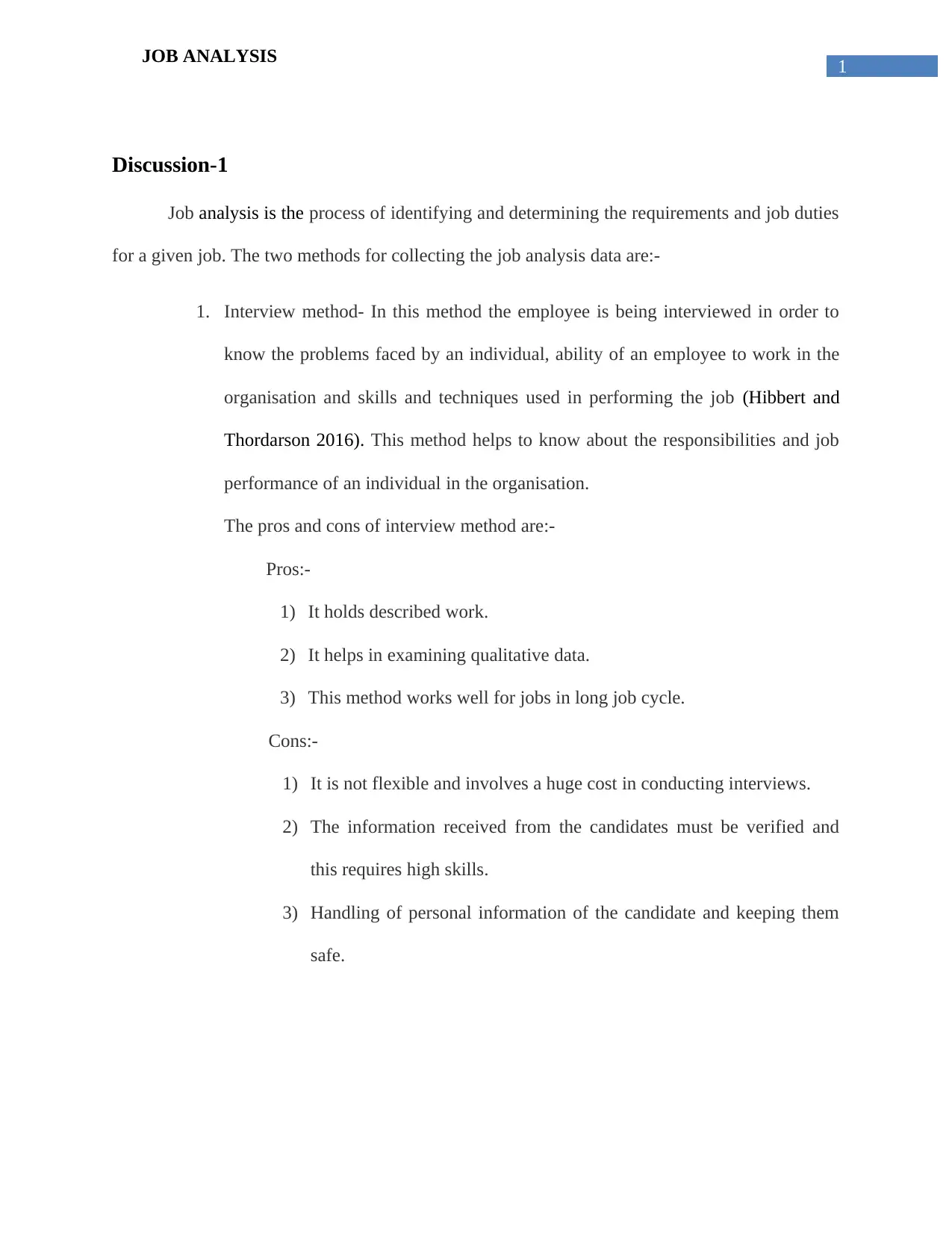
1
JOB ANALYSIS
Discussion-1
Job analysis is the process of identifying and determining the requirements and job duties
for a given job. The two methods for collecting the job analysis data are:-
1. Interview method- In this method the employee is being interviewed in order to
know the problems faced by an individual, ability of an employee to work in the
organisation and skills and techniques used in performing the job (Hibbert and
Thordarson 2016). This method helps to know about the responsibilities and job
performance of an individual in the organisation.
The pros and cons of interview method are:-
Pros:-
1) It holds described work.
2) It helps in examining qualitative data.
3) This method works well for jobs in long job cycle.
Cons:-
1) It is not flexible and involves a huge cost in conducting interviews.
2) The information received from the candidates must be verified and
this requires high skills.
3) Handling of personal information of the candidate and keeping them
safe.
JOB ANALYSIS
Discussion-1
Job analysis is the process of identifying and determining the requirements and job duties
for a given job. The two methods for collecting the job analysis data are:-
1. Interview method- In this method the employee is being interviewed in order to
know the problems faced by an individual, ability of an employee to work in the
organisation and skills and techniques used in performing the job (Hibbert and
Thordarson 2016). This method helps to know about the responsibilities and job
performance of an individual in the organisation.
The pros and cons of interview method are:-
Pros:-
1) It holds described work.
2) It helps in examining qualitative data.
3) This method works well for jobs in long job cycle.
Cons:-
1) It is not flexible and involves a huge cost in conducting interviews.
2) The information received from the candidates must be verified and
this requires high skills.
3) Handling of personal information of the candidate and keeping them
safe.
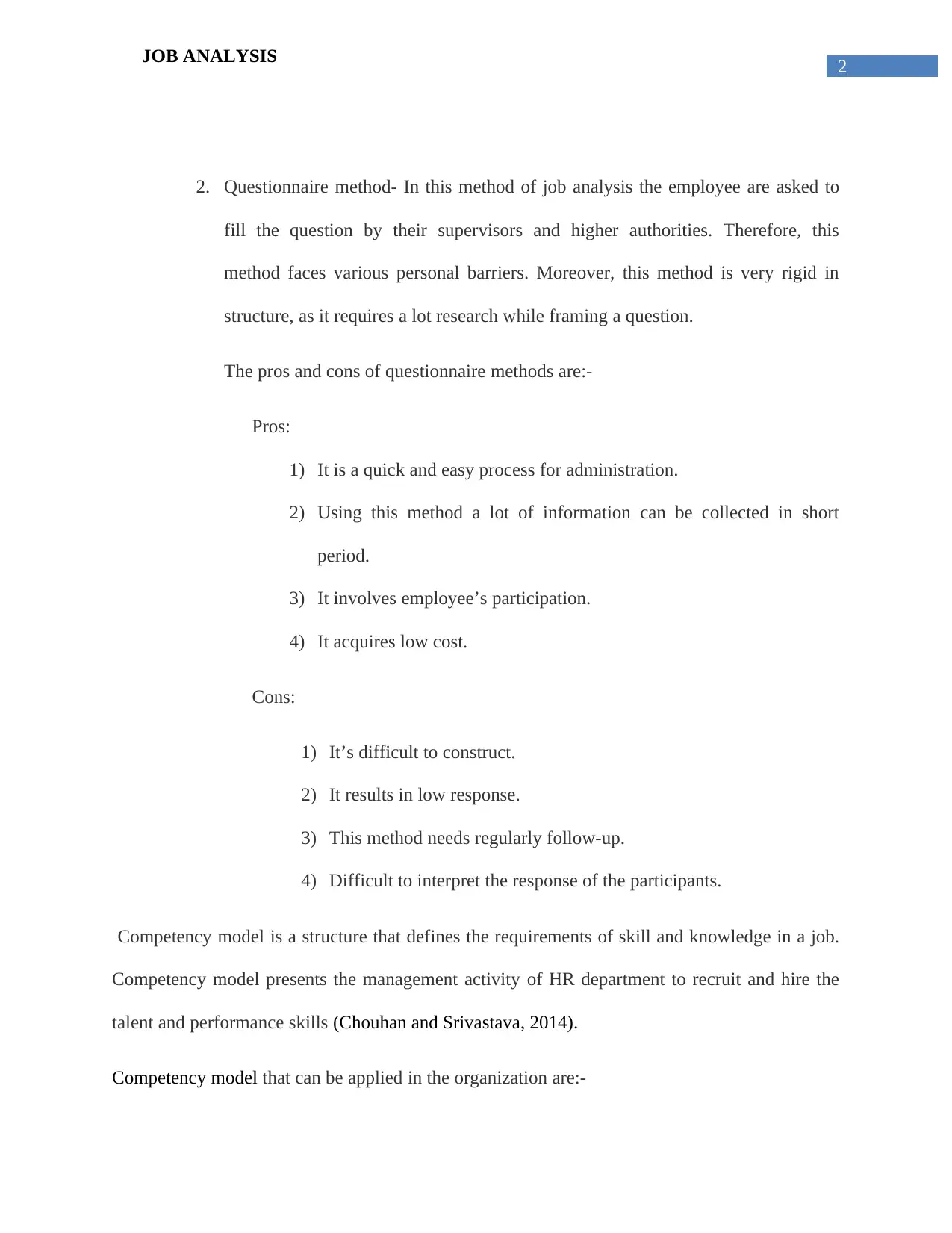
2
JOB ANALYSIS
2. Questionnaire method- In this method of job analysis the employee are asked to
fill the question by their supervisors and higher authorities. Therefore, this
method faces various personal barriers. Moreover, this method is very rigid in
structure, as it requires a lot research while framing a question.
The pros and cons of questionnaire methods are:-
Pros:
1) It is a quick and easy process for administration.
2) Using this method a lot of information can be collected in short
period.
3) It involves employee’s participation.
4) It acquires low cost.
Cons:
1) It’s difficult to construct.
2) It results in low response.
3) This method needs regularly follow-up.
4) Difficult to interpret the response of the participants.
Competency model is a structure that defines the requirements of skill and knowledge in a job.
Competency model presents the management activity of HR department to recruit and hire the
talent and performance skills (Chouhan and Srivastava, 2014).
Competency model that can be applied in the organization are:-
JOB ANALYSIS
2. Questionnaire method- In this method of job analysis the employee are asked to
fill the question by their supervisors and higher authorities. Therefore, this
method faces various personal barriers. Moreover, this method is very rigid in
structure, as it requires a lot research while framing a question.
The pros and cons of questionnaire methods are:-
Pros:
1) It is a quick and easy process for administration.
2) Using this method a lot of information can be collected in short
period.
3) It involves employee’s participation.
4) It acquires low cost.
Cons:
1) It’s difficult to construct.
2) It results in low response.
3) This method needs regularly follow-up.
4) Difficult to interpret the response of the participants.
Competency model is a structure that defines the requirements of skill and knowledge in a job.
Competency model presents the management activity of HR department to recruit and hire the
talent and performance skills (Chouhan and Srivastava, 2014).
Competency model that can be applied in the organization are:-
⊘ This is a preview!⊘
Do you want full access?
Subscribe today to unlock all pages.

Trusted by 1+ million students worldwide
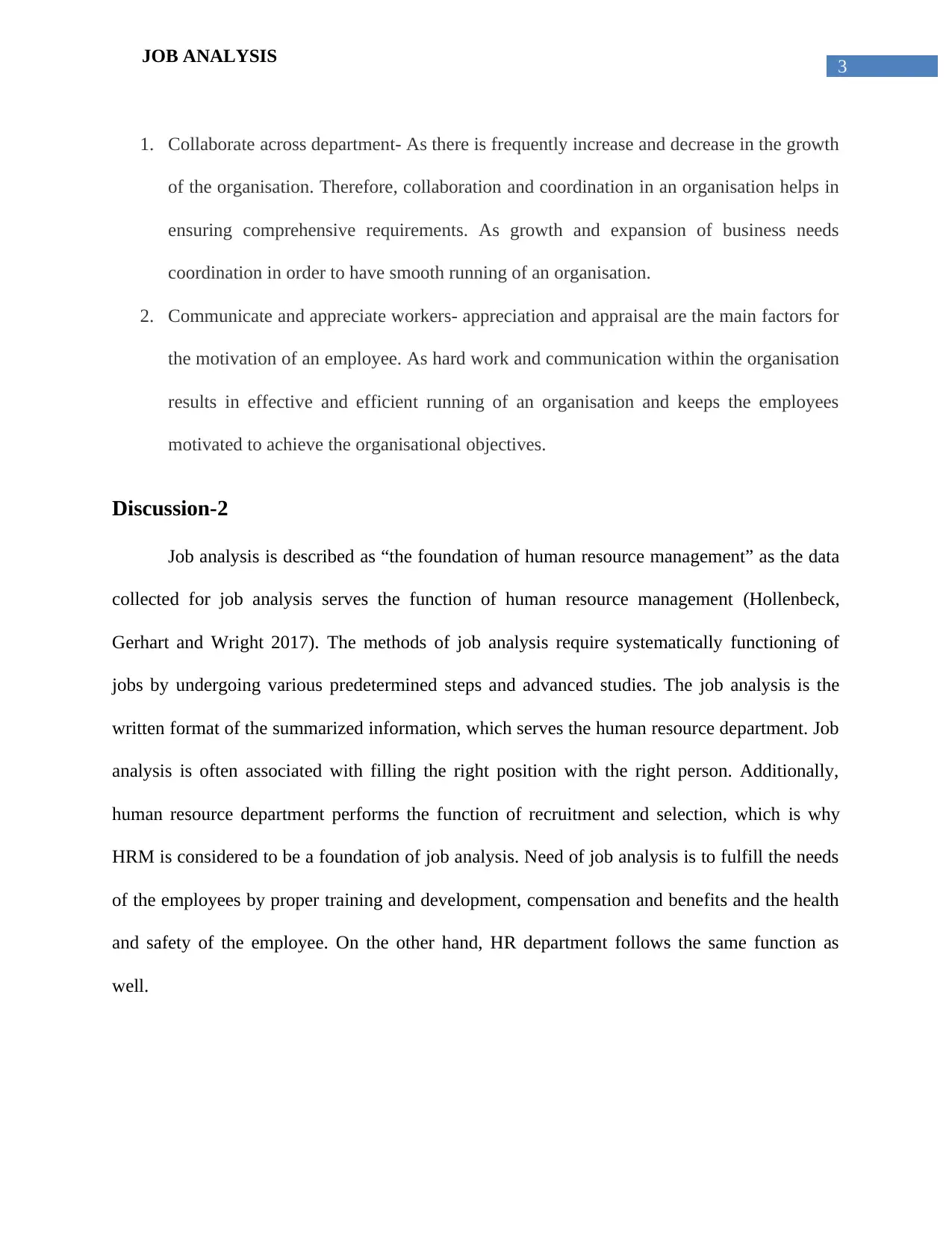
3
JOB ANALYSIS
1. Collaborate across department- As there is frequently increase and decrease in the growth
of the organisation. Therefore, collaboration and coordination in an organisation helps in
ensuring comprehensive requirements. As growth and expansion of business needs
coordination in order to have smooth running of an organisation.
2. Communicate and appreciate workers- appreciation and appraisal are the main factors for
the motivation of an employee. As hard work and communication within the organisation
results in effective and efficient running of an organisation and keeps the employees
motivated to achieve the organisational objectives.
Discussion-2
Job analysis is described as “the foundation of human resource management” as the data
collected for job analysis serves the function of human resource management (Hollenbeck,
Gerhart and Wright 2017). The methods of job analysis require systematically functioning of
jobs by undergoing various predetermined steps and advanced studies. The job analysis is the
written format of the summarized information, which serves the human resource department. Job
analysis is often associated with filling the right position with the right person. Additionally,
human resource department performs the function of recruitment and selection, which is why
HRM is considered to be a foundation of job analysis. Need of job analysis is to fulfill the needs
of the employees by proper training and development, compensation and benefits and the health
and safety of the employee. On the other hand, HR department follows the same function as
well.
JOB ANALYSIS
1. Collaborate across department- As there is frequently increase and decrease in the growth
of the organisation. Therefore, collaboration and coordination in an organisation helps in
ensuring comprehensive requirements. As growth and expansion of business needs
coordination in order to have smooth running of an organisation.
2. Communicate and appreciate workers- appreciation and appraisal are the main factors for
the motivation of an employee. As hard work and communication within the organisation
results in effective and efficient running of an organisation and keeps the employees
motivated to achieve the organisational objectives.
Discussion-2
Job analysis is described as “the foundation of human resource management” as the data
collected for job analysis serves the function of human resource management (Hollenbeck,
Gerhart and Wright 2017). The methods of job analysis require systematically functioning of
jobs by undergoing various predetermined steps and advanced studies. The job analysis is the
written format of the summarized information, which serves the human resource department. Job
analysis is often associated with filling the right position with the right person. Additionally,
human resource department performs the function of recruitment and selection, which is why
HRM is considered to be a foundation of job analysis. Need of job analysis is to fulfill the needs
of the employees by proper training and development, compensation and benefits and the health
and safety of the employee. On the other hand, HR department follows the same function as
well.
Paraphrase This Document
Need a fresh take? Get an instant paraphrase of this document with our AI Paraphraser
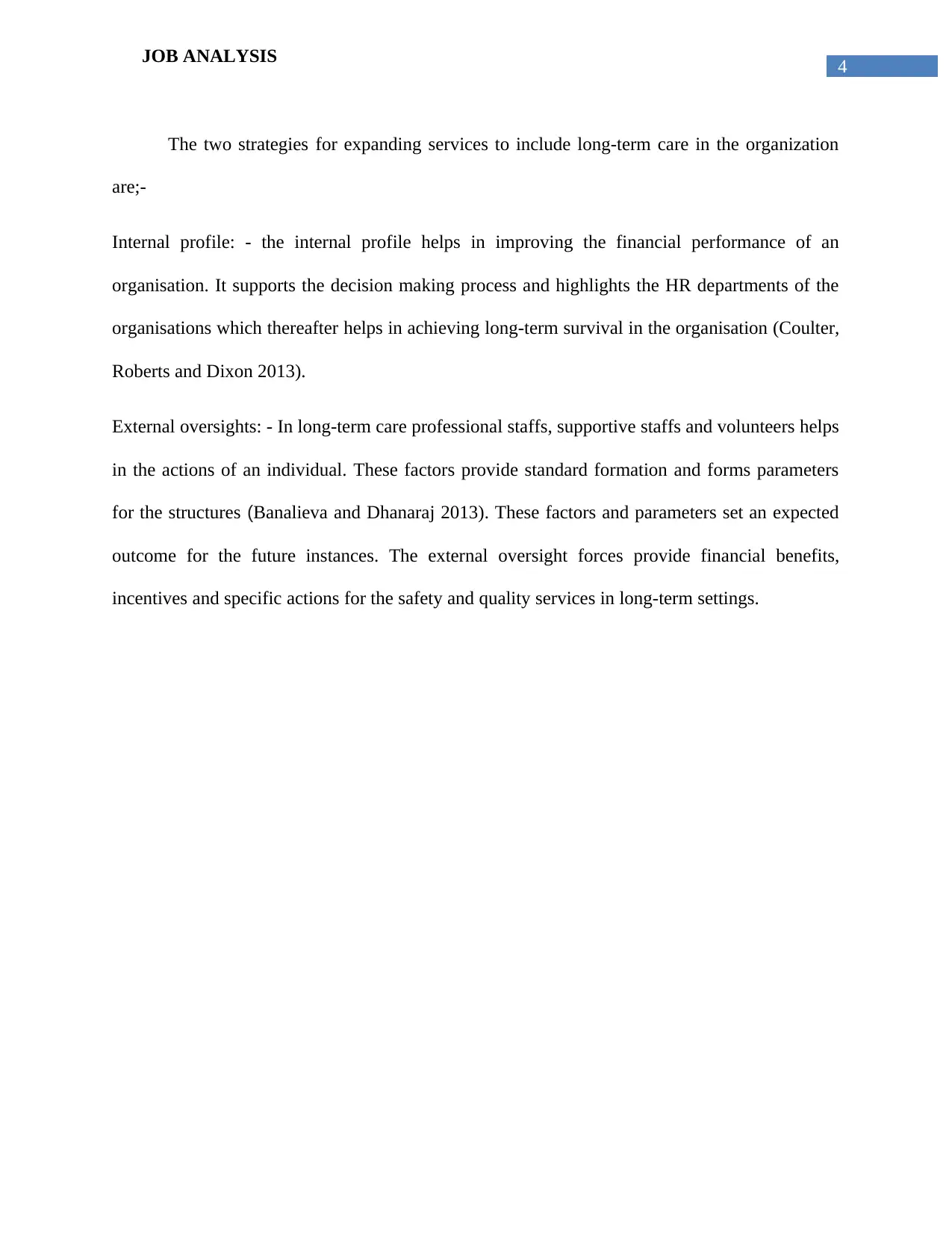
4
JOB ANALYSIS
The two strategies for expanding services to include long-term care in the organization
are;-
Internal profile: - the internal profile helps in improving the financial performance of an
organisation. It supports the decision making process and highlights the HR departments of the
organisations which thereafter helps in achieving long-term survival in the organisation (Coulter,
Roberts and Dixon 2013).
External oversights: - In long-term care professional staffs, supportive staffs and volunteers helps
in the actions of an individual. These factors provide standard formation and forms parameters
for the structures (Banalieva and Dhanaraj 2013). These factors and parameters set an expected
outcome for the future instances. The external oversight forces provide financial benefits,
incentives and specific actions for the safety and quality services in long-term settings.
JOB ANALYSIS
The two strategies for expanding services to include long-term care in the organization
are;-
Internal profile: - the internal profile helps in improving the financial performance of an
organisation. It supports the decision making process and highlights the HR departments of the
organisations which thereafter helps in achieving long-term survival in the organisation (Coulter,
Roberts and Dixon 2013).
External oversights: - In long-term care professional staffs, supportive staffs and volunteers helps
in the actions of an individual. These factors provide standard formation and forms parameters
for the structures (Banalieva and Dhanaraj 2013). These factors and parameters set an expected
outcome for the future instances. The external oversight forces provide financial benefits,
incentives and specific actions for the safety and quality services in long-term settings.
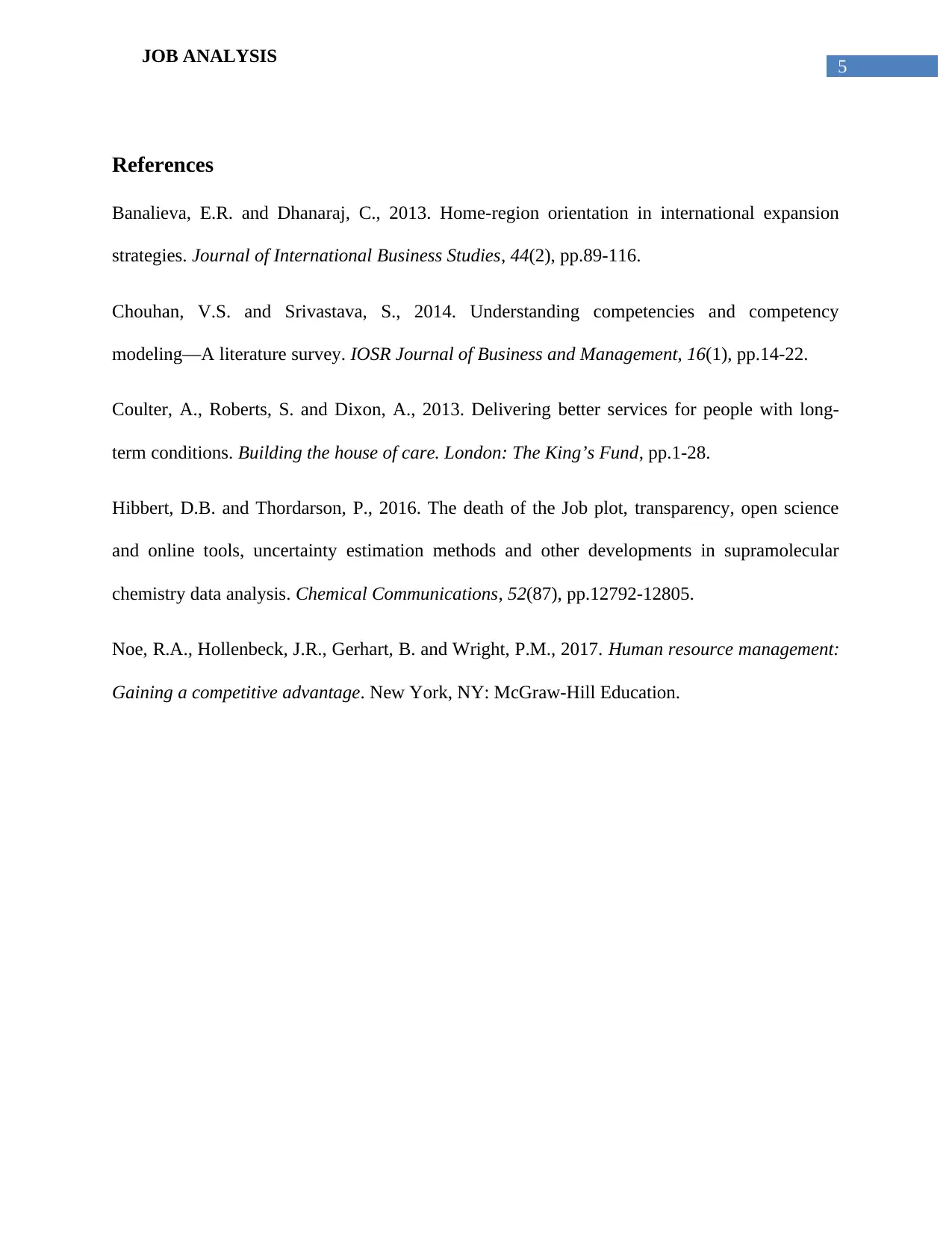
5
JOB ANALYSIS
References
Banalieva, E.R. and Dhanaraj, C., 2013. Home-region orientation in international expansion
strategies. Journal of International Business Studies, 44(2), pp.89-116.
Chouhan, V.S. and Srivastava, S., 2014. Understanding competencies and competency
modeling―A literature survey. IOSR Journal of Business and Management, 16(1), pp.14-22.
Coulter, A., Roberts, S. and Dixon, A., 2013. Delivering better services for people with long-
term conditions. Building the house of care. London: The King’s Fund, pp.1-28.
Hibbert, D.B. and Thordarson, P., 2016. The death of the Job plot, transparency, open science
and online tools, uncertainty estimation methods and other developments in supramolecular
chemistry data analysis. Chemical Communications, 52(87), pp.12792-12805.
Noe, R.A., Hollenbeck, J.R., Gerhart, B. and Wright, P.M., 2017. Human resource management:
Gaining a competitive advantage. New York, NY: McGraw-Hill Education.
JOB ANALYSIS
References
Banalieva, E.R. and Dhanaraj, C., 2013. Home-region orientation in international expansion
strategies. Journal of International Business Studies, 44(2), pp.89-116.
Chouhan, V.S. and Srivastava, S., 2014. Understanding competencies and competency
modeling―A literature survey. IOSR Journal of Business and Management, 16(1), pp.14-22.
Coulter, A., Roberts, S. and Dixon, A., 2013. Delivering better services for people with long-
term conditions. Building the house of care. London: The King’s Fund, pp.1-28.
Hibbert, D.B. and Thordarson, P., 2016. The death of the Job plot, transparency, open science
and online tools, uncertainty estimation methods and other developments in supramolecular
chemistry data analysis. Chemical Communications, 52(87), pp.12792-12805.
Noe, R.A., Hollenbeck, J.R., Gerhart, B. and Wright, P.M., 2017. Human resource management:
Gaining a competitive advantage. New York, NY: McGraw-Hill Education.
⊘ This is a preview!⊘
Do you want full access?
Subscribe today to unlock all pages.

Trusted by 1+ million students worldwide
1 out of 6
Related Documents
Your All-in-One AI-Powered Toolkit for Academic Success.
+13062052269
info@desklib.com
Available 24*7 on WhatsApp / Email
![[object Object]](/_next/static/media/star-bottom.7253800d.svg)
Unlock your academic potential
Copyright © 2020–2025 A2Z Services. All Rights Reserved. Developed and managed by ZUCOL.





